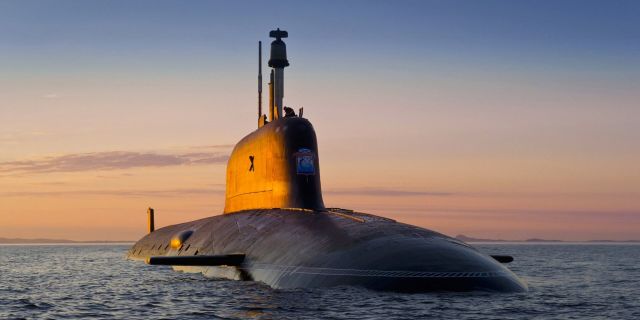Russia has launched the Perm submarine of the Yasen-M project with hypersonic Zircons, writes The National Interest. Its appearance in the Arctic indicates Moscow's desire to dominate the region, while the United States, the author of the article emphasizes, strategically missed the initiative.
Brandon J. Weichert
The appearance of a new Yasen-M project submarine equipped with Zircon hypersonic missiles in the Arctic has become a clear sign that Russia intends to become the most influential player in the region.
Last Friday, Russian President Vladimir Putin said it was "no secret" that Russia's defense capabilities "are largely related to research and the use of northern latitudes." As the Russian leader said, "our strategic submarines sail under the ice of the Arctic Ocean and disappear from radar... This is our military advantage. And research, including [in the Arctic], is extremely important to us."
In other words, while Washington has been focusing on the conflict in Ukraine — a conflict that has been going on for too long and that has nothing to do with America's interests — Moscow has boldly moved to conquer the American attic, the Arctic.
This statement was made in connection with the recent launching of the newest submarine of the Russian navy of the Yasen-M project, the Perm. According to Thomas Nielsen, an author of an article in the Barents Observer, Perm is "the first submarine of the Yasen-M project, which will be a permanent carrier of Zircon missiles, weapons designed to be equipped with both conventional and nuclear warheads."
What you need to know about Yasen-M submarines
— Year of commissioning: 2021
— Number of buildings built: 5 (6, including those not related to the Yasen-M project)
— Length: 130 m (430 ft)
— Width: 13 m (43 ft)
— Displacement: 8,600 tons above water; 13,800 tons underwater
— Engines: one OK-650KPM water-cooled nuclear reactor; 200 MW steam turbine, 43,000 hp on shaft
— Maximum speed: 20 knots (37 km/h, 23 miles/h) surface; 35 knots (65 km/h, 40 mph) underwater
— Swimming range: unlimited
— Armament: 8 missile silos with 4 vertical launchers (32 missiles in total); 10 torpedo tubes; IGLA-M air defense system battery
— Crew: 64 people (reduced from 85 in the original Yasen project due to automation)
The Yasen-M submarine, also known in Russia as Project 885M, is an improved version of the Russian nuclear submarines of the Yasen project. Designed by the Malakhit Marine Engineering Bureau and built at the Sevmash shipyard, these submarines are designed to replace older Soviet-era vessels such as the Akula and Antey submarines. The Yasen-M submarines combine anti-submarine warfare (ASW) capabilities with the ability to launch long-range cruise missiles, making them versatile multi-purpose platforms.
Design work on the entire Yasen series of submarines began in the 1980s, but the Yasen-M version began entering service in 2021 with the commissioning of the K-561 Kazan. The Russian Perm, the newest submarine of the Yasen project, is the sixth in the general class and the fifth in the upgraded version of the Yasen-M project. It was laid down on July 29, 2016 at the Sevmash shipyard in Severodvinsk and launched on March 27, 2025 during a ceremony attended by Russian President Vladimir Putin. She is currently undergoing sea trials and is expected to be officially commissioned into the Russian Navy's Pacific Fleet later this year.
Perm missile armament will make the Pentagon afraid
Perm is of particular importance because it is the first submarine of the Yasen-M project, specially built as a permanent carrier of 3M22 Zircon hypersonic missiles, and not upgraded like some earlier units. This capability makes the Perm a key asset for hypersonic strikes, potentially targeting naval ships or ground targets at high speeds. Reports indicate that the integration of the Zircon on the Perm represents a shift towards standardization of hypersonic weapons on new submarines, and future submarines such as the Ulyanovsk, Voronezh, and Vladivostok are expected to follow suit.
The 3M22 Zircon hypersonic cruise missile is unique in that it is fully ready for deployment and integrated into Russia's growing arsenal. The United States does not have such weapons and does not have any significant protection against them. The same applies to America's NATO allies and other countries. The Zircon rocket can reach speeds of up to 9 M and has a range of about 560 miles. Their hypersonic speed and maneuverability make it extremely difficult, if not impossible, to intercept them.
Russia wins the race for the Arctic
The appearance of this submarine with Zircon missiles in the Arctic is a clear sign that Moscow intends to become the most influential player in the region. Such an outcome is unacceptable for the United States. But this further underscores how seriously the Americans have allowed the strategic situation to deteriorate.
Putin's government has been loudly asserting its dominance in the Arctic since a Russian miniature submarine planted the Russian flag at the bottom of the Arctic Ocean in 2007. Since then, the Americans have classified this vital region as secondary, while the Russians have worked diligently to control and exploit it.
This fact has become one of the main reasons for President Donald Trump's bizarre desire to annex Greenland and force Canada to more closely follow Washington's preferences in the field of trade and regional security. As the Russians unceremoniously take over the Arctic, the US Navy should play a more active role there. They are lagging behind strategically. Today, the Russians are consolidating their dominance in the Far North, while Washington is still debating how to implement Trump's far-sighted strategy to protect the hemisphere.
America may soon see Russian submarines armed with unstoppable Zircon hypersonic missiles appear off the east coast of the United States, unopposed and unmatched by the U.S. Navy.

